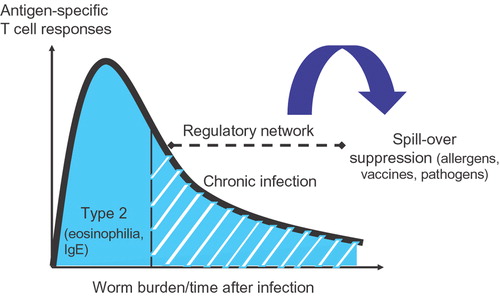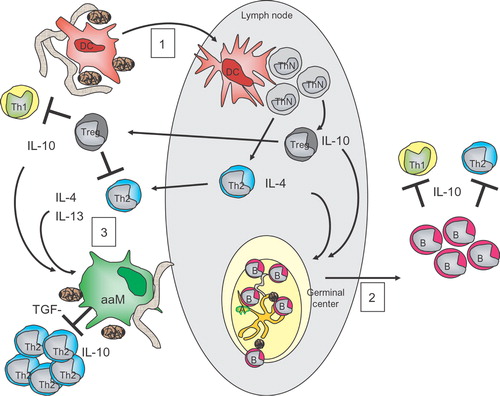Figures & data
Figure 1 Schematic overview of the forming of a regulatory network during chronic but not acute helminth infections. It is proposed that these regulatory networks are instrumental in the suppression of immune responses to bystander antigens, such as allergens.

Figure 2 Overview of immune modulation by helminths. 1) Immature dendritic cells (iDC) become activated by the exposure to either (compounds from) eggs (brown rod‐shaped symbols) or worms and will migrate through the draining lymph nodes (LN) while acquiring a mature phenotype. In the LN they will drive the development of polarized Th2 and regulatory T (Treg) cells, expressing IL‐4 and IL‐13 or IL‐10, respectively. These Treg cells, once they have migrated to the local site of inflammation, can inhibit the proliferation and effector function of other T cells. 2) Upon parasitic exposure together with harmless antigens, such as allergens, mature germinal centers (GC) are formed in the lymph nodes. In the GC B cells (B) are selected that recognize specific antigens, such as allergenic antigens, and will receive signals to develop into mature B cells. Some of these B cells have acquired the capacity to produce IL‐10 and will act as regulatory B cells at the peripheral site and will inhibit the effector function of other T cells. 3) Both the cytokines of Th2 cells and Treg cells, such as IL‐4, IL‐13 and IL‐10, as well as compounds from eggs or worms, can change the activation state of macrophages (MΦ), resulting in alternatively activated MΦ (aaMΦ). aaMΦ produce high levels of IL‐10 and TGF‐β instrumental in inhibiting the proliferation of other T cells, such as Th2 cells.
